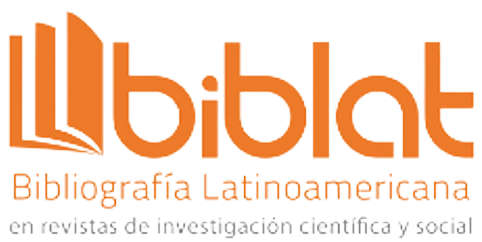Identificando Tecnologías Blockchain para la Protección de Información Sensible en Redes Sociales: Una Revisión Sistemática
Resumen
Este trabajo aborda la identificación de las tecnologías basadas en blockchain para la protección de datos de carácter sensible en las redes sociales que hoy por hoy son parte de nuestra vida cotidiana. Señala las tecnologías más relevantes de blockchain que están ganando terreno en la era tecnológica en la que nos encontramos. La metodología usada corresponde a los principios de la declaración PRISMA, utilizando repositorios de alta exigencia como SCOPUS, SCIELO, IEEE XPLORE, MDPI, IIETA, SAGE JOURNAL e IJCSE encontrando 25 documentos relevantes para el estudio. Estos últimos, centran sus investigaciones en el uso y aplicación de tecnologías blockchain en casos específicos de plataformas digitales saliendo a destacar 4 tecnologías: Blockchain híbrido, Contratos inteligentes, Blockchain público y la encriptación de datos. Los resultados señalan que son las tecnologías más usadas para la protección de información. Las conclusiones destacan la importancia de Blockchain en la protección de información, indicando Se identifican oportunidades para investigaciones futuras, en particular. casos de estudios más específicos donde se aproveche mucho mejor la tecnología en cuestión.
Descargas
Citas
I. R. Lima, V. Filipe, and C. Marinho, "ARTICONF decentralized social media platform for democratic crowd journalism," Social Network Analysis and Mining, vol. 13, no. 116, 2023. [Online]. Available: https://doi.org/10.1007/s13278-023-01110-y DOI: https://doi.org/10.1007/s13278-023-01110-y
S. A. Frimpong, M. Han, E. K. Boahen, R. N. A. Sosu, I. Hanson, O. Larbi-Siaw, and I. B. Senkyire, "RecGuard: An efficient privacy preservation blockchain-based system for online social network users," Blockchain: Research and Applications, vol. 4, no. 1, 2023. [Online]. Available: https://doi.org/10.1016/j.bcra.2022.100111 DOI: https://doi.org/10.1016/j.bcra.2022.100111
H. R. Hasan, K. Salah, R. Jayaraman, I. Yaqoob, and M. Omar, "NFTs for combating deepfakes and fake metaverse digital contents," Internet of Things, vol. 25, 2024. [Online]. Available: https://doi.org/10.1016/j.iot.2024.101133 DOI: https://doi.org/10.1016/j.iot.2024.101133
A. Leonardi and A. Wicaksana, "Protecting intellectual property with non-fungible token in decentralized social media," ICIC Express Letters, vol. 17, no. 6, pp. 625–630, 2023. [Online]. Available: https://doi.org/10.24507/icicel.17.06.625
S. Jadon, K. Bhat, K. R. Jenni, K. Vedantha, L. R. R., and P. B. Honnavalli, "Non-Fungible Token Enhanced Blockchain-Based Online Social Network," IEEE Access, vol. 12, pp. 92368-92385, 2024. [Online]. Available: https://doi.org/10.1109/ACCESS.2024.3422530 DOI: https://doi.org/10.1109/ACCESS.2024.3422530
E. A. Calderón Marenco and I. P. Raúdez Hernández, "Desinformación digital y democracia en Iberoamérica: Retos y oportunidades de la Lex Criptográfica," Derecho Global. Estudios sobre Derecho y Justicia, vol. 9, no. 26, pp. 377-401, 2024. [Online]. Available: https://www.scielo.org.mx/scielo.php?script=sci_arttext&pid=S2448-51362024000100015&lang=es
M. A. Hisseine, D. Chen, and X. Yang, "The Application of Blockchain in Social Media: A Systematic Literature Review," Applied Sciences, vol. 12, no. 13, 2022. [Online]. Available: https://doi.org/10.3390/app12136567 DOI: https://doi.org/10.3390/app12136567
Y. Zhan, Y. Xiong, and X. Xing, "A conceptual model and case study of blockchain-enabled social media platform," Technovation, vol. 119, 2023, Art no. 102610. [Online]. Available: https://doi.org/10.1016/j.technovation.2022.102610 DOI: https://doi.org/10.1016/j.technovation.2022.102610
A. D. Waghmare and G. K. Patnaik, "Fake News Detection of Social Media News in Blockchain Framework," Indian Journal of Computer Science and Engineering (IJCSE), vol. 12, no. 4, pp. 972-980, 2021. [Online]. Available: http://www.ijcse.com/abstract.html?file=21-12-04-151 DOI: https://doi.org/10.21817/indjcse/2021/v12i4/211204151
Y. Subbarayudu and A. Sureshbabu, "Cluster Visualized Topic Modeling Paradigms for Recognition of Health-Related Topics Through a Machine Learning," Ingénierie des Systèmes d'Information, vol. 29, no. 3, pp. 1015-1030, 2024. [Online]. Available: https://doi.org/10.18280/isi.290320 DOI: https://doi.org/10.18280/isi.290320
A. Nagappa, "Narratives of Change to Platform Governance on DTube, an Emerging Blockchain-Based Video-Sharing Platform," Social Media + Society, vol. 9, no. 3, 2023. [Online]. Available: https://doi.org/10.1177/20563051231196881 DOI: https://doi.org/10.1177/20563051231196881
Ö. Aslan, S. S. Aktuğ, M. Ozkan-Okay, A. A. Yilmaz, and E. Akin, "A Comprehensive Review of Cyber Security Vulnerabilities, Threats, Attacks, and Solutions," Electronics, vol. 12, no. 6, 2023. [Online]. Available: https://doi.org/10.3390/electronics12061333 DOI: https://doi.org/10.3390/electronics12061333
B. Guidi, "When Blockchain meets Online Social Networks," Pervasive and Mobile Computing, vol. 62, 2020, Art. no. 101131, doi: https://doi.org/10.1016/j.pmcj.2020.101131. DOI: https://doi.org/10.1016/j.pmcj.2020.101131
B. Guidi, V. Clemente, T. García, and L. Ricci, "A Rewarding Model for the next generation Social Media," in Proceedings of the 6th EAI International Conference on Smart Objects and Technologies for Social Good (GoodTechs '20), Antwerp, Belgium, 2020, pp. 169–174. doi: https://doi.org/10.1145/3411170.3411247. DOI: https://doi.org/10.1145/3411170.3411247
C. Li, B. Palanisamy, R. Xu, J. Xu, and J. Wang, "SteemOps: Extracting and Analyzing Key Operations in Steemit Blockchain-based Social Media Platform," in Proceedings of the Eleventh ACM Conference on Data and Application Security and Privacy (CODASPY '21), Virtual Event, USA, 2021, pp. 113–118. doi: https://doi.org/10.1145/3422337.3447845. DOI: https://doi.org/10.1145/3422337.3447845
M. J. Page, J. E. McKenzie, P. M. Bossuyt, I. Boutron, T. C. Hoffmann, C. D. Mulrow, L. Shamseer, J. M. Tetzlaff, E. A. Akl, S. E. Brennan, R. Chou, J. Glanville, J. M. Grimshaw, A. Hróbjartsson, M. M. Lalu, T. Li, E. W. Loder, E. Mayo-Wilson, S. McDonald, and D. Moher, "The PRISMA 2020 statement: An updated guideline for reporting systematic reviews," Journal of Clinical Epidemiology, vol. 134, pp. 178-189, 2021. [Online]. Available: https://doi.org/10.1016/j.jclinepi.2021.03.001 DOI: https://doi.org/10.31222/osf.io/v7gm2
J. Z. Llamas Covarrubias, "Transparencia y protección de datos personales en la cadena de bloques (blockchain)," Estudios En Derecho a La Información, vol. 1, no. 11, pp. 27-63, 2020. [Online]. Available: https://doi.org/10.22201/iij.25940082e.2021.11.15299 DOI: https://doi.org/10.22201/iij.25940082e.2021.11.15299
P. U. Waghe, A. S. Kumar, A. B. Prasad, V. S. Rao, E. Thenmozhi, S. R. Godla, and Y. A. B. El-Ebiary, "Blockchain-Enabled Cybersecurity Framework for Safeguarding Patient Data in Medical Informatics," International Journal of Advanced Computer Science and Applications (IJACSA), vol. 15, no. 3, 2024. [Online]. Available: http://dx.doi.org/10.14569/IJACSA.2024.0150381 DOI: https://doi.org/10.14569/IJACSA.2024.0150381
M. Y. Shakor, M. I. Khaleel, M. Safran, S. Alfarhood, and M. Zhu, "Dynamic AES Encryption and Blockchain Key Management: A Novel Solution for Cloud Data Security," IEEE Access, vol. 12, pp. 26334-26343, 2024. [Online]. Available: https://doi.org/10.1109/ACCESS.2024.3351119 DOI: https://doi.org/10.1109/ACCESS.2024.3351119
C. Awasthi, "Preservation of sensitive data using multi-level blockchain-based secured framework for edge network devices," Journal of Grid Computing, vol. 21, no. 4, p. 69, 2023. [Online]. Available: https://doi.org/10.1007/s10723-023-09699-2 DOI: https://doi.org/10.1007/s10723-023-09699-2
Y. Qu, "Towards Privacy-Aware and Trustworthy Data Sharing Using Blockchain for Edge Intelligence," Big Data Mining and Analytics, vol. 6, no. 4, pp. 443-464, Dec. 2023. [Online]. Available: https://doi.org/10.26599/BDMA.2023.9020012 DOI: https://doi.org/10.26599/BDMA.2023.9020012
H. N. Alsuqaih, W. Hamdan, H. Elmessiry, and H. Abulkasim, "An efficient privacy-preserving control mechanism based on blockchain for E-health applications," Alexandria Engineering Journal, vol. 73, pp. 159-172, 2023. [Online]. Available: https://doi.org/10.1016/j.aej.2023.04.037 DOI: https://doi.org/10.1016/j.aej.2023.04.037
A. A. Alanazi, F. K. Karim, S. A. Ghorashi, G. Amoudi, and S. H. A. Hamza, "Blockchain with optimal deep learning assisted secure data sharing and classification on future healthcare systems," Alexandria Engineering Journal, vol. 99, pp. 168-179, 2024. [Online]. Available: https://doi.org/10.1016/j.aej.2024.05.023 DOI: https://doi.org/10.1016/j.aej.2024.05.023
Y. Li, L. Liang, Y. Jia, W. Wen, C. Tang, and Z. Chen, "Blockchain for Data Sharing at the Network Edge: Trade-Off Between Capability and Security," IEEE/ACM Transactions on Networking, vol. 32, no. 3, pp. 2616-2630, Jun. 2024. [Online]. Available: https://doi.org/10.1109/TNET.2024.3364023 DOI: https://doi.org/10.1109/TNET.2024.3364023
S. Mohammed, N. Al-Aaraji, and A. Al-Saleh, "Comparative analysis of blockchain platforms for security enhancement in online social networks," Ingénierie des Systèmes d’Information, vol. 29, no. 1, pp. 19-25, 2024. [Online]. Available: https://doi.org/10.18280/isi.290103 DOI: https://doi.org/10.18280/isi.290103
R. Zhu, M. Wang, X. Zhang, et al., "Investigation of personal data protection mechanism based on blockchain technology," Scientific Reports, vol. 13, no. 21918, 2023. [Online]. Available: https://doi.org/10.1038/s41598-023-48661-w DOI: https://doi.org/10.1038/s41598-023-48661-w
Derechos de autor 2025 Innovación y Software

Esta obra está bajo licencia internacional Creative Commons Reconocimiento 4.0.
Los autores ceden en exclusiva el derecho de publicación de su artículo a la Revista Innovación y Software, que podrá editar o modificar formalmente el texto aprobado para cumplir con las normas editoriales propias y con los estándares gramaticales universales, antes de su publicación; asimismo, nuestra revista podrá traducir los manuscritos aprobados a cuantos idiomas considere necesario y difundirlos en varios países, dándole siempre el reconocimiento público al autor o autores de la investigación.
























